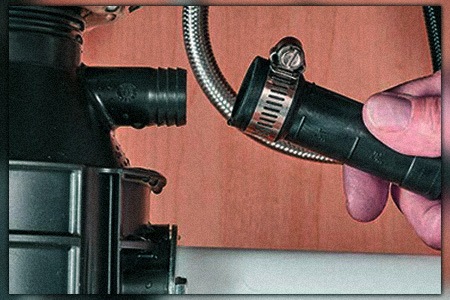Our Definitive Guide to Fixing a Leaky Waste Disposal Unit
Our Definitive Guide to Fixing a Leaky Waste Disposal Unit
Blog Article
We've noticed this great article on How to fix a pretty consistent leak from my garbage disposal directly below on the web and thought it made perfect sense to discuss it with you in this article.

Garbage disposals are vital cooking area devices that help in getting rid of food waste successfully. Nonetheless, a leaking waste disposal unit can be an irritating and messy trouble to take care of. Thankfully, lots of leakages can be taken care of easily with a couple of basic steps. In this article, we will certainly go over how to repair a dripping waste disposal unit properly.
Introduction
Waste disposal unit are installed under cooking area sinks and are created to shred food waste into smaller sized pieces, permitting it to go through the plumbing system quickly. While these devices are normally dependable, leaks can happen with time due to deterioration, loose links, or damages to the device.
Usual Sources Of Leaks in Waste Disposals
Worn Seals and Gaskets
Seals and gaskets play an essential role in stopping water from dripping out of the garbage disposal. Over time, these elements can deteriorate, resulting in leakages around the disposal device.
Loose Links
The connections between the waste disposal unit and the pipes system can come to be loosened with time, creating water to leak out throughout procedure.
Splits or Openings in the Disposal Unit
Physical damage to the waste disposal unit, such as fractures or holes in the real estate, can additionally cause leakages.
Determining the Source of the Leak
Before attempting to repair a leaking waste disposal unit, it is vital to identify the source of the leak. This can usually be done with visual assessment or by carrying out basic examinations.
Visual Inspection
Evaluate the waste disposal unit device very carefully for any signs of water leak. Pay attention to areas around seals, gaskets, and link points.
Testing for Leaks
One means to test for leakages is by running water via the disposal system and looking for any type of noticeable indicators of leakage.
Devices and Materials Needed for Taking Care Of a Dripping Garbage Disposal
Before beginning the fixing process, collect the essential devices and products, consisting of a screwdriver, adjustable wrench, plumbing's putty, substitute seals or gaskets, and epoxy or patching product for repairing splits or holes.
Step-by-Step Guide to Dealing With a Dripping Garbage Disposal
Switch off the Power
Prior to attempting any kind of repair services, make sure that the power to the waste disposal unit unit is shut off to prevent the danger of electric shock.
Situate the Leakage
Determine the specific location of the leakage and identify the reason.
Tighten up Connections
Make use of a wrench to tighten any type of loosened links in between the disposal device and the plumbing system.
Change Seals or Gaskets
If the leakage is because of worn seals or gaskets, eliminate the old elements and replace them with new ones.
Patching Fractures or Openings
For cracks or holes in the disposal unit, use epoxy or an ideal patching product to secure the damaged location.
Evaluating the Waste Disposal Unit After Fixing
As soon as the repair is total, test the garbage disposal by running water via it to make certain that the leakage has actually been dealt with.
Preventive Maintenance Tips to Avoid Future Leakages
To prevent future leaks, it is vital to do regular maintenance on your waste disposal unit. This consists of keeping it tidy, preventing placing non-food products or tough items down the disposal, and regularly checking for leakages or other problems.
Conclusion
Finally, repairing a leaking waste disposal unit is a reasonably straightforward process that can be completed with basic tools and materials. By adhering to the steps outlined in this post and exercising precautionary maintenance, you can maintain your garbage disposal in good working problem and stay clear of costly repair work in the future.
HERE’S HOW TO FIX YOUR GARBAGE DISPOSAL
WHAT TO DO IF SOMETHING IS STUCK IN YOUR GARBAGE DISPOSAL
If the impeller won’t turn, there’s probably something stuck in the disposal. It could be a steak bone or peach pit, although plumbers report pulling all sorts of inappropriate objects out of disposals, such as bottle caps or aluminum foil. Make sure power to the disposal is off, and look inside to see if you can see the source of the jam.
Never stick your fingers in a disposal. Pull out anything you see with tongs or pliers.
If the disposal still won’t work, it may be time to call a plumber or consider buying a new disposal. GEM Plumbing & Heating is here for all of your garbage disposal needs.
WHAT TO DO IF YOUR GARBAGE DISPOSAL DRAIN IS CLOGGED
Take everything out from underneath your sink and put a bucket or other container under your disposal to catch any water that drains out. Disconnect your disposal from the power supply. If it’s plugged into a wall outlet, unplug it. If it’s hardwired into an electrical box, go to the electrical panel and turn off the breaker for the disposal. Pour ¼ cup of baking soda into the drain, followed by ½ cup of white vinegar. Give the solution a few minutes to fizz and do its work. Look into the disposal with a flashlight to see if you can see an object that might be causing the clog. If you see it, remove it using tongs or pliers. MORE TIPS ON DEALING WITH A CLOGGED GARBAGE DISPOSAL
Never use drain cleaner in a garbage disposal. It can damage the plastic parts inside the disposal. You can also be splashed with the caustic liquid while working to clear the clog. Beware! Never stick your fingers into a garbage disposal. Trust us — not a good idea. In many instances, your dishwasher drains through your garbage disposal. This allows the disposal to grind any large food particles that may be drained out of your dishwasher. There are some jurisdictions, however, where the plumbing code prohibits such a connection. WHAT TO DO WHEN YOUR DISHWASHER DRAINS THROUGH THE DISPOSAL
Run some water in the sink so your plunger has at least a ½-inch of water to create a seal and plunge vigorously up and down several times. You may need to repeat this several times. Run hot water down the drain to clear any residue that remains.

I stumbled upon that blog post on Tips on Fixing a Leaking Garbage Disposal while doing research the search engines. Sharing is good. Helping people is fun. Thank-you for taking the time to read it.
Information Report this page